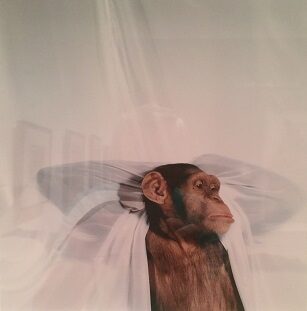
James Balog
American, 1952-
Chimpanzee with Curtain, 1991
chromogenic print
9 3/8 x 9 1/8 in.
SBMA, Gift of Arthur B. Steinman
2000.50.10

James Balog with camera - Undated Photo
"I've always believed that photography is a way to shape human perception." - James Balog
RESEARCH PAPER
James Balog is an American photographer, filmmaker, scientist, educator and policy influencer on the topic of climate change. Much in the way that Ansel Adams is heralded for his documentation of the grandeur of the American West in hopes to promote its conservation, Balog is following suit for the issues that plague our generation: the impacts of a warming climate. With a master’s degree in Geomorphology, Balog followed the belief that the warming earth was part of a natural cycle that had occurred throughout its existence. However, it was through this exploration and associated photography that his opinion was formed. “[It] has been a revelation for me, to realize I’m in the midst of monumental geologic change that’s going to change the face of the Earth forever, and I’ve got this tool, this camera, with which to witness the change and to bring the story back” [Ritchin, 2010, p. 82]. As a result, Balog’s career has been to focus his lens on nature and wildlife, spending the past thirty plus years documenting the intersection of humans and nature. Two areas where he has found early impact are with the melting ice sheets as well as endangered species.
In the photograph “Chimpanzee with Curtain”, Balog is highlighting how the changing environment is directly impacting the chimpanzee (as well as other animals in this series) due to the changes in where they live. These images take the animals out of their natural habitat and into a sterile environment, such as a studio. By seeing the animals out of context, the impacts to their existence and survival are highlighted, acknowledging their displacement, lost homes, and precarious hope for survival. “I see this stuff as being a metaphor for us,” Balog said recently, surrounded in the gallery by the exhibit’s 16 large prints. “I don’t see this as just being about animals, about something outside of Homo sapiens. What’s happening in a lot of these pictures is that there’s some sort of response between our collective unconscious and these animals. I think you’re sort of recognizing yourself.” (S. Appleford, LA Times, 1/27/91). As the climate crisis escalates, this point seems even more salient in 2020 than 1991.
Balog has spent decades trying to call attention to the topic of climate change with evidentiary photography disputing the notions of regular climate cycles by climate change deniers. He is most noted for his use of time lapse photography to document the changes that have occurred over multi-year periods. His film: “Chasing Ice” is an Emmy and multi-award winning documentary highlighting his photographic documentation. “Marrying still photographs, video, and film with the written word and other media, we hope that our work is an antidote to natural amnesia. We preserve a visual record of fast-changing landscapes and critically endangered animals and plants and then disseminate this record to the global public using all available forums, including the Internet, electronic and print media, public presentations, and educational resources created for classrooms.” (J.Balog, http://jamesbalog.com)
Prepared for the Santa Barbara Museum of Art Docent Council by Anne-Marie Dunaway, 2020.
BIBLIOGRAPHY
https://www.latimes.com/archives/la-xpm-1991-01-27-ca-547-story.html
https://www.nationalgeographic.com/contributors/b/photographer-james-balog/
https://www.ted.com/speakers/james_balog
http://jamesbalog.com
Ritchin, F. (2010). ‘Of art and ice: James Balog’. Aperture 198, pp. 80–83
COMMENTS
For three decades, James Balog [“BAY-log”] has been a leader in photographing and interpreting the natural environment. An avid mountaineer with a graduate degree in geography and geomorphology, James is equally at home on a Himalayan peak or a whitewater river, the African savannah or polar icecaps.
To reveal the impact of climate change, James founded the Extreme Ice Survey (EIS), the most wide-ranging, ground-based, photographic study of glaciers ever conducted. The project is featured in the highly acclaimed documentary, Chasing Ice, which won the award for Excellence in Cinematography at the 2012 Sundance Film Festival, as well as dozens of awards at film festivals worldwide. Chasing Ice was shortlisted for the 2013 Academy Awards. It has been screened at The White House, the U.S. Congress, the U.K. House of Commons and the United Nations. It has been the subject of features on the NBC Evening News, ABC Nightline, The Late Show with David Letterman, PBS’s Moyers & Company, and Real Time with Bill Maher.
With genes found to be 98.4% identical to Homo sapiens, chimpanzees are our link to the animal kingdom. Published in 1993, James Balog’s Anima (a title derived from the thinking of C. G. Jung and James Hillman) challenges our ancient cultural assumptions about humanity’s lofty perch in the world. Anima asks us to re-imagine and re-create a healthier, more integrated relationship between humans and nature.
http://jamesbalog.com/about-james/
